Quick Look
Grade Level: 5 (4-6)
Time Required: 1 hours 30 minutes
(two 45-minute class periods)
Expendable Cost/Group: US $20.00
Group Size: 3
Activity Dependency: None
Subject Areas: Biology, Chemistry, Life Science, Measurement, Physical Science, Problem Solving
NGSS Performance Expectations:

| 3-5-ETS1-1 |
| 3-5-ETS1-2 |
| 3-5-ETS1-3 |
Summary
In this activity, students learn about the engineering design process and use it to solve a design problem involving detergent and dirty clothes. The problem presented is a spot on a favorite shirt while on a camping trip. Students move through the engineering design process, as they design, build, and test a prototype of a portable washing machine.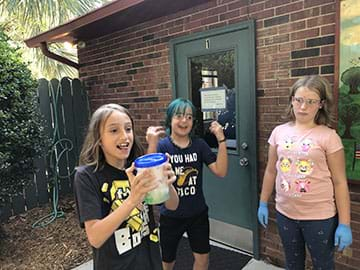
Engineering Connection
Mechanical and chemical engineers develop solutions to real-world problems using their knowledge of physical science. The problems that engineers solve can take a variety of forms. Even something as simple as a spot on a shirt can be an opportunity to engineer a solution. Engineers can use the concepts of motion and force to create a machine that removes laundry stains.
Learning Objectives
After this activity, students should be able to:
- Define a problem that includes specified criteria for success and constraints on materials, time, or cost.
- List the steps of the engineering design process (ask, research, imagine, plan, create, test, improve).
- Use the steps of the Engineering Process to imagine, plan, create, test and improve a prototype to solve a problem.
Educational Standards
Each TeachEngineering lesson or activity is correlated to one or more K-12 science,
technology, engineering or math (STEM) educational standards.
All 100,000+ K-12 STEM standards covered in TeachEngineering are collected, maintained and packaged by the Achievement Standards Network (ASN),
a project of D2L (www.achievementstandards.org).
In the ASN, standards are hierarchically structured: first by source; e.g., by state; within source by type; e.g., science or mathematics;
within type by subtype, then by grade, etc.
Each TeachEngineering lesson or activity is correlated to one or more K-12 science, technology, engineering or math (STEM) educational standards.
All 100,000+ K-12 STEM standards covered in TeachEngineering are collected, maintained and packaged by the Achievement Standards Network (ASN), a project of D2L (www.achievementstandards.org).
In the ASN, standards are hierarchically structured: first by source; e.g., by state; within source by type; e.g., science or mathematics; within type by subtype, then by grade, etc.
NGSS: Next Generation Science Standards - Science
| NGSS Performance Expectation | ||
|---|---|---|
|
3-5-ETS1-1. Define a simple design problem reflecting a need or a want that includes specified criteria for success and constraints on materials, time, or cost. (Grades 3 - 5) Do you agree with this alignment? |
||
| Click to view other curriculum aligned to this Performance Expectation | ||
| This activity focuses on the following Three Dimensional Learning aspects of NGSS: | ||
| Science & Engineering Practices | Disciplinary Core Ideas | Crosscutting Concepts |
| Define a simple design problem that can be solved through the development of an object, tool, process, or system and includes several criteria for success and constraints on materials, time, or cost. Alignment agreement: | Possible solutions to a problem are limited by available materials and resources (constraints). The success of a designed solution is determined by considering the desired features of a solution (criteria). Different proposals for solutions can be compared on the basis of how well each one meets the specified criteria for success or how well each takes the constraints into account. Alignment agreement: | People's needs and wants change over time, as do their demands for new and improved technologies. Alignment agreement: |
| NGSS Performance Expectation | ||
|---|---|---|
|
3-5-ETS1-2. Generate and compare multiple possible solutions to a problem based on how well each is likely to meet the criteria and constraints of the problem. (Grades 3 - 5) Do you agree with this alignment? |
||
| Click to view other curriculum aligned to this Performance Expectation | ||
| This activity focuses on the following Three Dimensional Learning aspects of NGSS: | ||
| Science & Engineering Practices | Disciplinary Core Ideas | Crosscutting Concepts |
| Generate and compare multiple solutions to a problem based on how well they meet the criteria and constraints of the design problem. Alignment agreement: | Research on a problem should be carried out before beginning to design a solution. Testing a solution involves investigating how well it performs under a range of likely conditions. Alignment agreement: At whatever stage, communicating with peers about proposed solutions is an important part of the design process, and shared ideas can lead to improved designs.Alignment agreement: | Engineers improve existing technologies or develop new ones to increase their benefits, to decrease known risks, and to meet societal demands. Alignment agreement: |
| NGSS Performance Expectation | ||
|---|---|---|
|
3-5-ETS1-3. Plan and carry out fair tests in which variables are controlled and failure points are considered to identify aspects of a model or prototype that can be improved. (Grades 3 - 5) Do you agree with this alignment? |
||
| Click to view other curriculum aligned to this Performance Expectation | ||
| This activity focuses on the following Three Dimensional Learning aspects of NGSS: | ||
| Science & Engineering Practices | Disciplinary Core Ideas | Crosscutting Concepts |
| Plan and conduct an investigation collaboratively to produce data to serve as the basis for evidence, using fair tests in which variables are controlled and the number of trials considered. Alignment agreement: | Tests are often designed to identify failure points or difficulties, which suggest the elements of the design that need to be improved. Alignment agreement: Different solutions need to be tested in order to determine which of them best solves the problem, given the criteria and the constraints.Alignment agreement: | |
International Technology and Engineering Educators Association - Technology
-
Students will develop an understanding of the role of society in the development and use of technology.
(Grades
K -
12)
More Details
Do you agree with this alignment?
-
Students will develop an understanding of the attributes of design.
(Grades
K -
12)
More Details
Do you agree with this alignment?
-
Students will develop an understanding of engineering design.
(Grades
K -
12)
More Details
Do you agree with this alignment?
-
Students will develop an understanding of the role of troubleshooting, research and development, invention and innovation, and experimentation in problem solving.
(Grades
K -
12)
More Details
Do you agree with this alignment?
-
Students will develop abilities to apply the design process.
(Grades
K -
12)
More Details
Do you agree with this alignment?
Materials List
Each person needs:
Each group needs:
- 3 white rags (100% cotton)
- squeezable container of mustard
- black Sharpie marker
- tray or a plate
- plastic spoon
- plastic gloves (optional)
- safety goggles (optional)
For the class to share:
- water
- enzymatic laundry detergent (such as Seventh Generation Free & Clear; other brands available online)
- Ziploc plastic bags (gallon sized)
- Ziploc Plastic storage containers (quart sized)
- marbles (enough for several per group)
- dice (enough for several per group)
- 100 mL pourable containers or graduated cylinders
Worksheets and Attachments
Visit [www.teachengineering.org/activities/view/uof-2499-clean-green-washing-machine-challenge-activity] to print or download.Introduction/Motivation
Have you ever spilled food on yourself and worried that the stain would ruin your shirt? Well, today I want you to imagine that you are on a camping trip with your family. You are about to sink your teeth into a juicy hot dog with your family at lunch when you accidentally squirt the mustard on your favorite white shirt instead of on your hot dog. Oh no! What are you going to do? You are in the woods with no washing machine nearby. Luckily, your mom packed a small container of enzymatic laundry detergent and you can get water from the creek, but is that enough to get the stain out? What could you do to create a portable washing machine on a camping trip?
Procedure
Before the Activity:
Teacher preparation in the days before the activity:
- Purchase materials such as the mustard, enzymatic laundry detergent, white cotton rags, plastic spoons, Ziploc bags, Ziploc containers, marbles, dice and plastic gloves.
- Cut cotton rags into 15cm x 15cm squares (6” x 6” squares).
- Print worksheets (one for each student)
Teacher preparation on the day of the activity:
- Prepare water in pourable containers – 1000 mL for each group of students.
- Prepare trays or plates to put under the rags when staining.
- Set up a supplies area with the Ziploc bags, Ziploc containers, marbles and dice for the students to create their washing machine prototypes.
- Set up an area for students to get the water and enzymatic laundry detergent for each trial.
- Set up an area for students to rinse their rags after testing their prototypes – either in a sink or in wash buckets filled with water.
- Get camera or cell phone to take photos of students as they design, build and test their prototypes.
With the Students:
Day 1
Goal of Day 1 – Review the Engineering Design Process, Build and Test Initial Prototype
Introduce Engineering Design Process:
- Show video: The Engineering Process Crash Course Kids or What is Engineering? on TeachEngineering.
- Hand out the Engineering Design Process Worksheet.
- Go through worksheet step by step (Ask, Research, Imagine, Plan, Create, Test, Improve) with students.
Introduce Activity:
- Refer to the K-W-L chart from the associated lesson, The Power of Enzymes!, and keep that available for the duration of the activity (See Pre-Activity Assessment below).
- Hand out the Lab Notes Worksheet to all students.
- Tell students that this lab notes worksheet is to document their activity.
- Provide students with pencils and markers and/or colored pencils.
- Instruct students to fill in #1 on their worksheet – Team Name(s) at the top of the worksheet.
- Let students know they can use the back of their worksheet to sketch out their initial prototype design ideas with their team.
Trial 1
Step 1 – Creating the mustard stain (shown in Figure 1)
- Provide each group of students with a tray or plate, a white cotton rag, a black sharpie marker, a pair of plastic gloves, a plastic spoon, and a squeezable container of mustard.
- Tell the students to draw a circle (about three inches in diameter) on the white cotton rag with their black sharpie marker.
- Tell the students to choose one member of their group to squeeze the mustard on to the white cotton rag to make a stain. They may use the spoon to spread out the mustard to fill the circle. Tell the students to be sure to fill up the circle with the mustard stain and keep the area outside of the circle white.
- Instruct students to complete #2 on their worksheet - Picture of Your Rag Before Challenge. Color how your stain looks before cleaning.
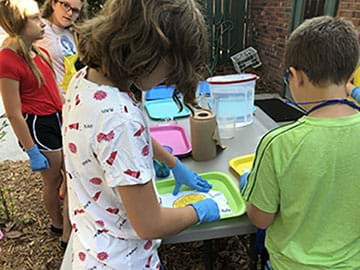
Step 2 – Creating the washing machine prototype (shown in Figure 2)
- Instruct each team to choose their type of washing container - either a Ziploc gallon size bag or a Ziploc quart size container.
- Instruct students to complete #3 on their worksheet – Washing Container under the column for Trial 1.
- Instruct each team to choose their type of agitator - marbles or dice.
- Instruct students to complete #4 on their worksheet – Type of Agitator under the column for Trial 1.
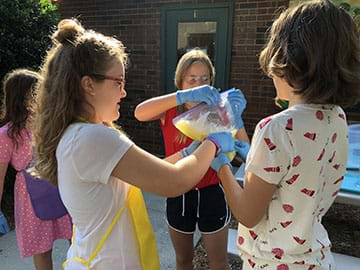
Step 3 – Testing the washing machine prototype (shown in Figure 3)
- Instruct each team to pour 30 mL of enzymatic laundry detergent into their washing machine prototype.
- Instruct students to complete #6 on their worksheet – Amount of Detergent (in mL) under the column for Trial 1.
- Instruct each team to pour 500 mL of water into their washing machine prototype.
- Instruct students to complete #7 on their worksheet – Amount of Water (in mL) under the column for Trial 1.
- Instruct each team to count how many times they shake their prototype or count how long they shake their prototype (in minutes).
- Instruct students to complete #5 on their worksheet – Time Shaken under the column for Trial 1.
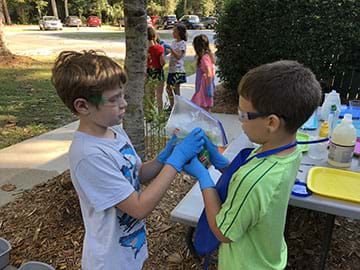
Step 4 – Rinsing the rag after testing (shown in Figure 4)
- Instruct students to take their rag out of their prototype washing machine.
- Instruct students to rinse their rag thoroughly in the sink or a wash basin and squeeze out excess water.
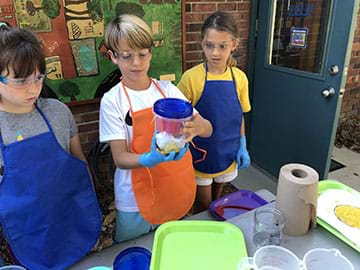
Step 5 – Documenting the Results
- Instruct students to complete #8 on their worksheet – Picture of Rag After Cleaning under the column for Trial 1 using a marker or colored pencil to show what the rag looks like after it has been washed in the prototype and rinsed.
- Instruct students to complete #9 on their worksheet – Describe Any Changes under the column for Trial 1.
End of Day 1
- Collect the Lab Notes Worksheet from all students.
- Have students help clean up their work area.
Day 2
Review Day 1
- Hand out the Lab Notes Worksheet from Day 1 to all students.
- Goal of Day 2 – To make improvements to initial prototype from Day 1 and retest improved prototype in two additional trials.
Trial 2
- Repeat steps 1 through 4 from Trial 1 (Day 1).
Step 5 – Documenting the Results
- Instruct students to complete #8 on their worksheet – Picture of Rag After Cleaning under the column for Trial 2 using a marker or colored pencil to show what the rag looks like after it has been washed in the prototype and rinsed.
- Instruct students to complete #9 on their worksheet – Describe Any Changes under the column for Trial 2.
Trial 3
- Repeat steps 1 through 4 from Trial 2 (Day 2).
Step 5 – Documenting the Results
- Instruct students to complete #8 on their worksheet – Picture of Rag After Cleaning under the column for Trial 3 using a marker or colored pencil to show what the rag looks like after it has been washed in the prototype and rinsed.
- Instruct students to complete #9 on their worksheet – Describe Any Changes under the column for Trial 3.
- Instruct students to complete #10 on their worksheet – Which Trial Worked Best? Why?
- End of Day 3 - Have students help clean up their work area.
Vocabulary/Definitions
agitator: An apparatus for stirring or mixing liquid.
engineering: Imagining, designing, and building things that solve problems and make our lives better.
enzymatic laundry detergent: A product that cleans laundry using enzymes.
washing machine: A mechanical structure that uses power to apply forces and control movement to wash laundry.
Assessment
Pre-Activity Assessment
KWL: Write these K-W-L statements on a board (or large sticky note) and have them on-hand to refer back to for the duration of the activity.
| K | W | L |
| What we Know about Engineering | What Want to Know about Engineering | What We Learned about Engineering |
|
|
Post-Activity Assessment
| K | W | L |
| What we Know about Engineering | What Want to Know about Engineering | What We Learned about Engineering |
|
|
|
Safety Issues
While the detergent should not agitate skin, provide students with rubber gloves and safety goggles as a best practice when working with chemicals.
Subscribe
Get the inside scoop on all things TeachEngineering such as new site features, curriculum updates, video releases, and more by signing up for our newsletter!More Curriculum Like This

Students are introduced to the correct technical vocabulary for lighting, which is different than layperson's terms. They learn about lamp (light bulb) technology and how to identify the various types of lighting in their spaces. They are also introduced to lighting controls as a means for saving en...

What do enzymes and engineering have in common? As a catalyst that creates a chemical reaction, enzymes are a unique substance that chemical engineers can learn from to create their own unique chemical designs. In this lesson, students learn about enzymes, study how enzymes work in our digestive sys...
Copyright
© 2020 by Regents of the University of Colorado; original © 2019 University of FloridaContributors
Kristine BourSupporting Program
Multidisciplinary Research Experiences for Teachers of Elementary Grades, Herbert Wertheim College of Engineering, University of FloridaAcknowledgements
This curriculum was based upon work supported by the National Science Foundation under RET grant no. EEC 1711543— Engineering for Biology: Multidisciplinary Research Experiences for Teachers in Elementary Grades (MRET) through the College of Engineering at the University of Florida. Any opinions, findings, and conclusions or recommendations expressed in this material are those of the authors and do not necessarily reflect the views of the National Science Foundation.
Last modified: January 18, 2022







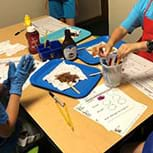
User Comments & Tips